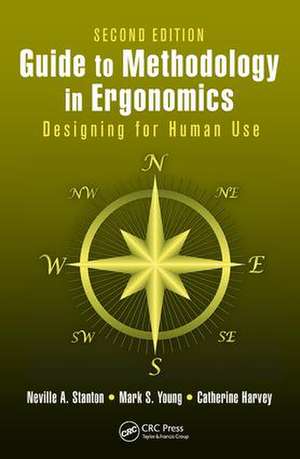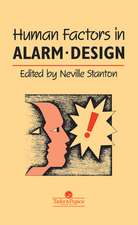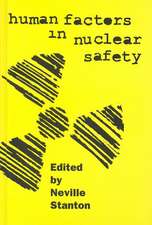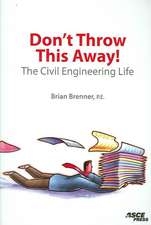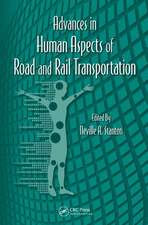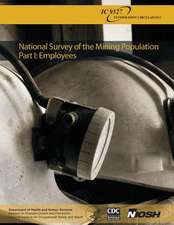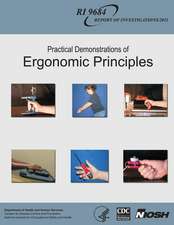Guide to Methodology in Ergonomics: Designing for Human Use, Second Edition
Autor Neville a. Stanton, Mark S. Young, Catherine Harveyen Limba Engleză Hardback – 20 sep 2017
| Toate formatele și edițiile | Preț | Express |
|---|---|---|
| Paperback (1) | 349.16 lei 6-8 săpt. | |
| CRC Press – 23 iun 2014 | 349.16 lei 6-8 săpt. | |
| Hardback (1) | 1040.52 lei 6-8 săpt. | |
| CRC Press – 20 sep 2017 | 1040.52 lei 6-8 săpt. |
Preț: 1040.52 lei
Preț vechi: 1403.02 lei
-26% Nou
Puncte Express: 1561
Preț estimativ în valută:
199.15€ • 207.13$ • 166.89£
199.15€ • 207.13$ • 166.89£
Carte tipărită la comandă
Livrare economică 14-28 martie
Preluare comenzi: 021 569.72.76
Specificații
ISBN-13: 9781138434721
ISBN-10: 1138434728
Pagini: 140
Dimensiuni: 156 x 234 mm
Greutate: 0.34 kg
Ediția:2
Editura: CRC Press
Colecția CRC Press
ISBN-10: 1138434728
Pagini: 140
Dimensiuni: 156 x 234 mm
Greutate: 0.34 kg
Ediția:2
Editura: CRC Press
Colecția CRC Press
Public țintă
Academic and Professional Practice & DevelopmentCuprins
Introduction. Case Studies: Keystroke Level Model. Link Analysis. Layout Analysis. Predictive Human Error Analysis. Observation. Questionnaires. Hierarchical Task Analysis. Repertory Grids. Task analysis for Error Identification. Layout analysis. Interviews. Heuristics. Utility Analysis. Training, Reliability and Validity. Bibliography. Author Index. Subject Index.
Recenzii
"This book provides an updated guide to several ergonomics methods for analyzing tasks and cognitive performance at work. The methods are described in readily understandable language and illustrated with practical examples. This book will be a valuable addition to the arsenal of the ergonomics practitioner."
—Alan Hedge is a Professor in the Department of Design and Environmental Analysis, Cornell University and a Research Professor in the Department of Mechanical and Aerospace Engineering at Syracuse University
"Stanton, Young, and Harvey have performed a signal service to the profession of ergonomics by bringing together in one place a lexicon of methods which permit the practitioner to enact their craft. Carefully selected from an even wider landscape of investigative techniques, these individual methods are highlighted, explicated, and integrated for those who look to operate in the real-world. The text then is a vital resource to all those who look to affect design, production, maintenance, and sustainability in ever more complex and resilient operational systems. Evolving from and updated with respect to an already classic resource, the present text provides convenient and relevant solutions to problems posed in all realms of human-technology interaction. Destined to take its place alongside other multi-edition classics, the present work is not merely about ergonomic tools but is a vital ergonomics tool in and of itself. This book should be in the locker of all those who practice ergonomics. Their investment in it will be repaid manifold, a modern and evolving classic of our times and of our profession."
—Peter Hancock, University of Central Florida
"Ergonomists need not only to understand various methods for evaluating and improving the design of artificial products, environments, and systems, but also to have the ability to choose the best method according to the purpose and situation. This book reviews 12 practical ergonomic methods for evaluating and improving the design of devices and interfaces. The main point of the book is to interpret the advantages and disadvantages of each method in detail from the ergonomic and financial perspectives. Interestingly, this book rates each method according to four perspectives: reliability/validity, resources, usability, and efficacy. [This helps] readers to choose the best method for the design on which they are working."
—Satoshi Muraki, Faculty of Design, Kyushu University, Japan
—Alan Hedge is a Professor in the Department of Design and Environmental Analysis, Cornell University and a Research Professor in the Department of Mechanical and Aerospace Engineering at Syracuse University
"Stanton, Young, and Harvey have performed a signal service to the profession of ergonomics by bringing together in one place a lexicon of methods which permit the practitioner to enact their craft. Carefully selected from an even wider landscape of investigative techniques, these individual methods are highlighted, explicated, and integrated for those who look to operate in the real-world. The text then is a vital resource to all those who look to affect design, production, maintenance, and sustainability in ever more complex and resilient operational systems. Evolving from and updated with respect to an already classic resource, the present text provides convenient and relevant solutions to problems posed in all realms of human-technology interaction. Destined to take its place alongside other multi-edition classics, the present work is not merely about ergonomic tools but is a vital ergonomics tool in and of itself. This book should be in the locker of all those who practice ergonomics. Their investment in it will be repaid manifold, a modern and evolving classic of our times and of our profession."
—Peter Hancock, University of Central Florida
"Ergonomists need not only to understand various methods for evaluating and improving the design of artificial products, environments, and systems, but also to have the ability to choose the best method according to the purpose and situation. This book reviews 12 practical ergonomic methods for evaluating and improving the design of devices and interfaces. The main point of the book is to interpret the advantages and disadvantages of each method in detail from the ergonomic and financial perspectives. Interestingly, this book rates each method according to four perspectives: reliability/validity, resources, usability, and efficacy. [This helps] readers to choose the best method for the design on which they are working."
—Satoshi Muraki, Faculty of Design, Kyushu University, Japan
Notă biografică
Neville A. Stanton, Mark S. Young, Catherine Harvey
Descriere
Packed with illustrations and practical examples, Guide to Methodology in Ergonomics: Designing for Human Use, Second Edition provides a concise introduction to ergonomics methods in a straightforward manner that helps you conduct an ergonomics analysis of a product in development
